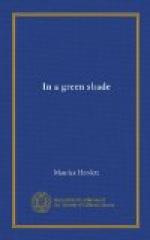In Dorothy Wordsworth’s journals, you may have the delight of daily intercourse—famigliarmente discorrendo—with one of the purest and noblest souls ever housed in flesh; to that you may add the reassurance to be got from word and implication beyond doubt. She tells us much, but implies more. We may see deeply into ourselves, but she sees deeply into a deeper self than most of us can discern. It is not only that, knowing her, we are grounded in the rudiments of honour and lovely living; it is to learn that human life can be so lived, and to conclude that of that at least is the Kingdom of Heaven.
These journals are for fragments only of the years which they cover, and as such exist for Jan.-May, 1798 (Alfoxden); May-Dec, 1800, Oct.-Dec, 1801, Jan.-July, 1802: all these at Grasmere. They have been printed by Professor Knight, and I have the assurance of Mr. Gordon Wordsworth that what little has been omitted is unimportant. Nothing is unimportant to me, and I wish the whole had been given us; but what we have is enough whereby to trace the development of her extraordinary mind and of her power of self-expression. The latter, undoubtedly, grew out of emotion, which gradually culminated until the day of William Wordsworth’s marriage. There it broke, and with it, as if by a determination of the will, there the revelation ceased. A new life began with the coming of Mary Wordsworth to Dove Cottage, a life of which Dorothy records the surface only.
The Alfoxden fragment (20 Jan.-22 May, 1798), written when she was twenty-seven, is chiefly notable for its power of interpreting landscape. That was a power which Wordsworth himself possessed in a high degree. There can be no doubt, I think, that they egged each other on, but I myself should find it hard to say which was egger-on and which the egged. This is the first sentence of it:
“20 Jan.—The green paths down the hillsides are channels for streams. The young wheat is streaked by silver lines of water running between the ridges, the sheep are gathered together on the slopes. After the wet dark days, the country seems more populous. It peoples itself in the sunbeams.”
Here is one of a few days later:
“23rd.—Bright sunshine; went out at 3 o’cl. The sea perfectly calm blue, streaked with deeper colour by the clouds, and tongues or points of sand; on our return of a gloomy red. The sun gone down. The crescent moon, Jupiter and Venus. The sound of the sea distinctly heard on the tops of the hills, which we could never hear in summer. We attribute this partly to the bareness of the trees, but chiefly to the absence of the singing birds, the hum of insects, that noiseless noise which lives in the summer air. The villages marked out by beautiful beds of smoke. The turf fading into the mountain road.”
She handles words, phrases, like notes or chords of music, and never gets her landscape by direct description. One more picture and I must leave it:




